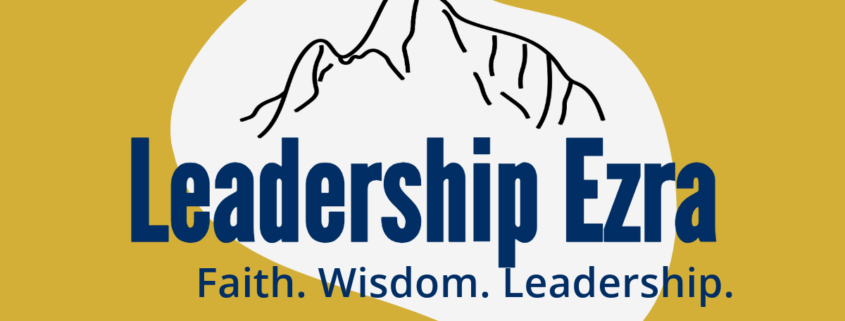Leadership Ezra: Who’s In Charge Here? (Part 5, Go!)
In thirty years of life and experience in leadership roles in Christian organizations, there are lessons that I learned (and continue to learn) from the life of ministry to which God called me. Over that time, He taught me lessons based on stories, principles, and truths from the Bible that have been translated into personal application. This series of articles focuses on a set of those lessons drawn from the book of Ezra in the Old Testament (and then published in my latest book). This week (along with the last two weeks, and in honor of the upcoming Olympic Games in Paris) we are starting the race of leadership. Today, in part 5, it’s “Go!,” when the starter’s gun goes off and the runners take off and run the race.
In my first year as the head of a school, I was enthusiastic and organized, with big dreams and a plan that I was developing and implementing. At first, though, I kept finding myself getting frustrated, because I would have seemingly constant interruptions that kept me from getting to the tasks that I need to do in order to carry out my plans. I know now how foolish this sounds, but I was getting frustrated because people were getting in the way of the tasks. Eventually it dawned on me that people were part of the job, so to alleviate the frustration, I began to designate specific time periods each day for people. And of course, people couldn’t seem to keep their interruptions confined to the times I had designated (you can read sarcasm into this). Finally, God smacked me over the head by reminding me of a former pastor’s sermon in which the message had repeatedly emphasized that people matter to God. I realized that the work of ministry is primarily about people, because people matter to God (and therefore they should matter to me), even though tasks are a necessary part of the work of effective leadership. I finally understood that leadership is about both people and tasks, and that the real challenge is in undertaking the work of leadership in a way that accomplishes tasks well while also meeting the needs of people in a way that draws them toward God.
Years of research and study on leadership by many researchers have concluded that the work of leadership does indeed boil down to these two things: tasks and people. At its core, effective leadership must be able to manage and direct the tasks appropriate to the circumstances, and at the same time manage and direct the people involved in a relational way that develops them individually. Very simply, it means getting the job done well, while working well with people and making them better in the process.
In practice, though, this is hard, and leadership is more complex than this, because there are lots of variables in both tasks and people: different personality types, different circumstances, different strengths and weaknesses, different obstacles, different tasks, and so on. And beyond that, it takes lots of work to develop a vision, then make plans, and finally implement the vision and plans in a way that most effectively accomplishes the tasks and leads people. The reality is that the work of leadership is daunting. However, the book of Ezra can and does help with this, providing some valuable lessons that help us identify important principles that make the work of leadership more effective. In his story, we find lessons that are beneficial for our own personal spiritual growth, but that are also applicable to our role as leaders. Specifically, Ezra chapters 7-10 illustrates ten actions that are necessary in leadership: three things to get and seven things to do.
First, there are three things to get:
- Permission: Getting permission can come from superiors, who give the necessary approval needed before getting a green light to go, but it also needs to come from below, by getting buy-in from followers. If they haven’t agreed to follow your lead, very little movement is going to take place.
- People: Getting people involves the task of identifying the necessary strengths needed for the task, and then assembling the best group of people to accomplish those tasks.
- Resources: Getting resources involves gathering those things – tools, supplies, finances, or people and skill sets – that must be assembled before beginning the tasks. First identify what you have available and then identify and solicit any additional needed resources. Figure out the resources you have and the resources you need.
With those three things in hand there are then seven things to do:
- Give recognition: Give credit where credit is due, immediately and at the front end of the process. First and most importantly, give honor to God, acknowledging that He is ultimately sovereign and responsible. People also need to be recognized and feel valued, believing that they are important to the process and the vision, and so recognizing them early (and often) affirms their value and enhances their level of commitment. Therefore, it is important to recognize the benefactors, the idea-makers, the planners, the leaders, the contributors, and the participants.
- Give people a voice: Give people an opportunity to speak and be heard, then listen to what they say. Often, those who are on the ground floor, or in the trenches, have an awareness and understanding of the obstacles, the needs, the details, etc., that the leadership does not clearly see because they are further removed from it. Therefore, there is great value in intentionally soliciting input and validating concerns and viewpoints; and where appropriate, that input should be used to modify or adjust the plans.
- Select the leaders: Gather a team that reflects the two purposes of oversight and representation. Those who are charged with oversight are people from among the leadership who have the task of overseeing and managing both the planning process and the implementation of the plan. Those who are charged with representation are people from among the followers who serve to represent and act on behalf of the people. Both kinds of leaders must be people submitted to God, and both are necessary for the work, therefore both need to be included in the teams you assemble.
- Define the purpose: The idea of purpose is related to the two questions of “Where are we going?” and “Why are we going there?” Answering the question of “where” happens when people can see the big picture, the overall goal. Answering the question of “why” happens when people understand motive, and it must be a motive that resonates with them. In any task, the motive must be clearly established and communicated.
- Determine the direction: Once the purpose has been established, direction can be given, both near (in the short-term) and far (in the long-term). Determining the right way to go (direction) naturally follows determining purpose, because once you know where you are going and why you are going there, you can then identify the path you need to take to get there. Like mapping out a road trip, this includes determining the next step or stop, and then the one after that, and so on, as well as determining the overall route.
- Establish the process: The process is the flow, the way in which everything takes place and connects together. The process of implementing a plan takes time and also brings many challenges, but there are important factors that – if communicated at the front of the process – will in turn help the process to flow well. These factors are: boundaries, including both limits and freedoms; methods, or, how the process will happen; and timing, including a schedule, checkpoints, and completion. Establishing these factors early will serve to greatly enhance the smoothness of the process.
- Provide the structure: A procedure provides the necessary guidelines for implementing a plan. The first procedural step is to meet, gathering the necessary people together to clearly communicate and initiate the plan. The last step is to celebrate (giving credit to God), and in between the first and last steps are incremental goals, or benchmarks, that need to be achieved (and should also be celebrated). Along the way, it is necessary to periodically assess progress and communicate.
At its most basic level, the work of leadership centers around and involves both people and tasks, and it is hard work that requires an intentional plan which includes these three things to get and seven things to do. It is, however, also incredibly fulfilling to be an instrument in God’s plan in that work. As His instrument, our desire and effort should be to do this work with excellence, and understanding these ten components will help us to do so. And when you reach the destination, don’t forget to celebrate, and don’t forget to give credit to God.





